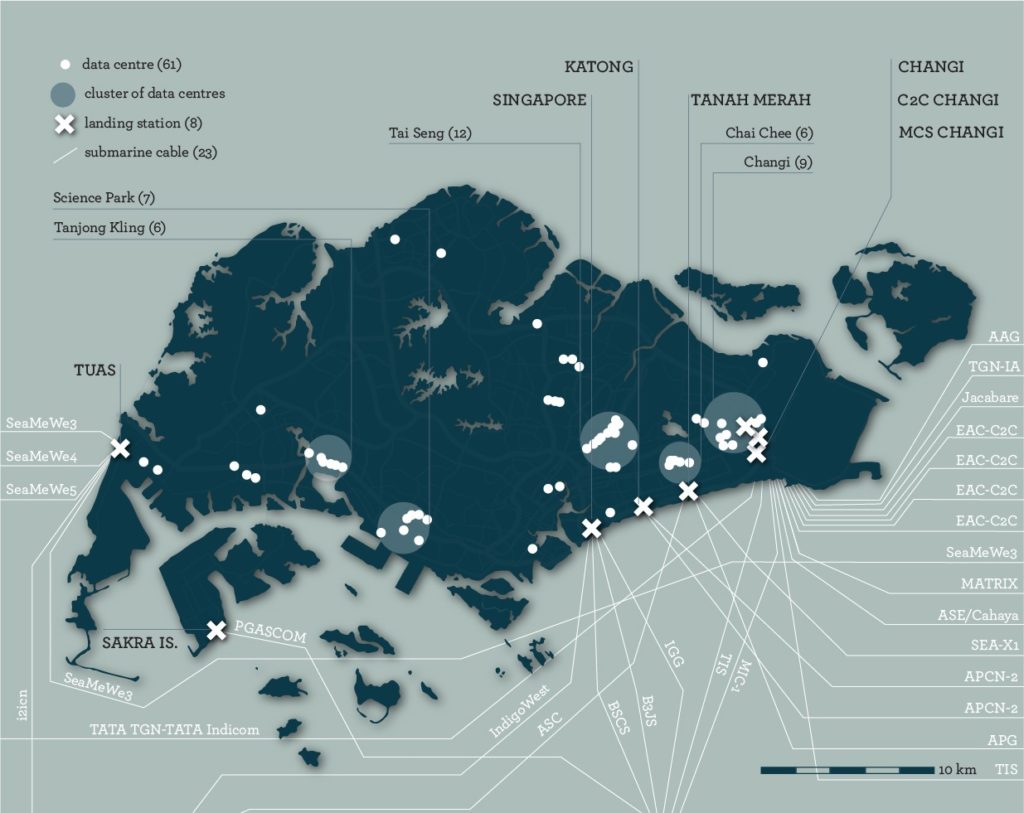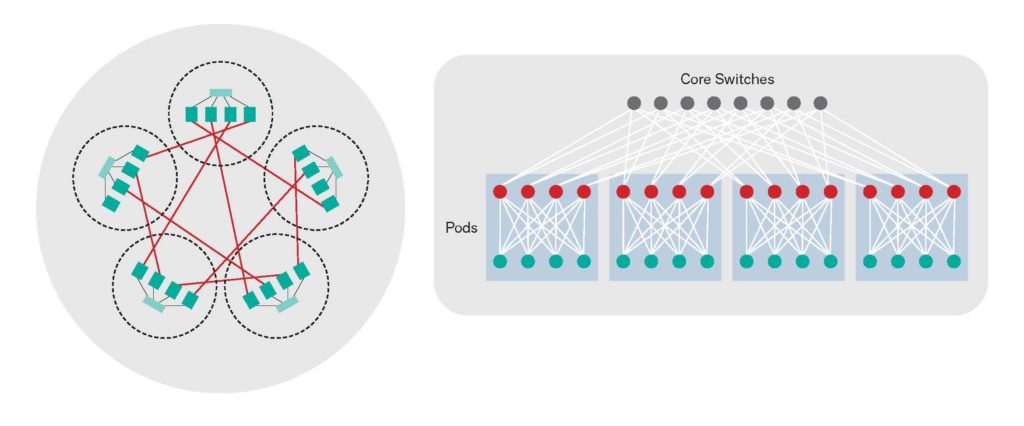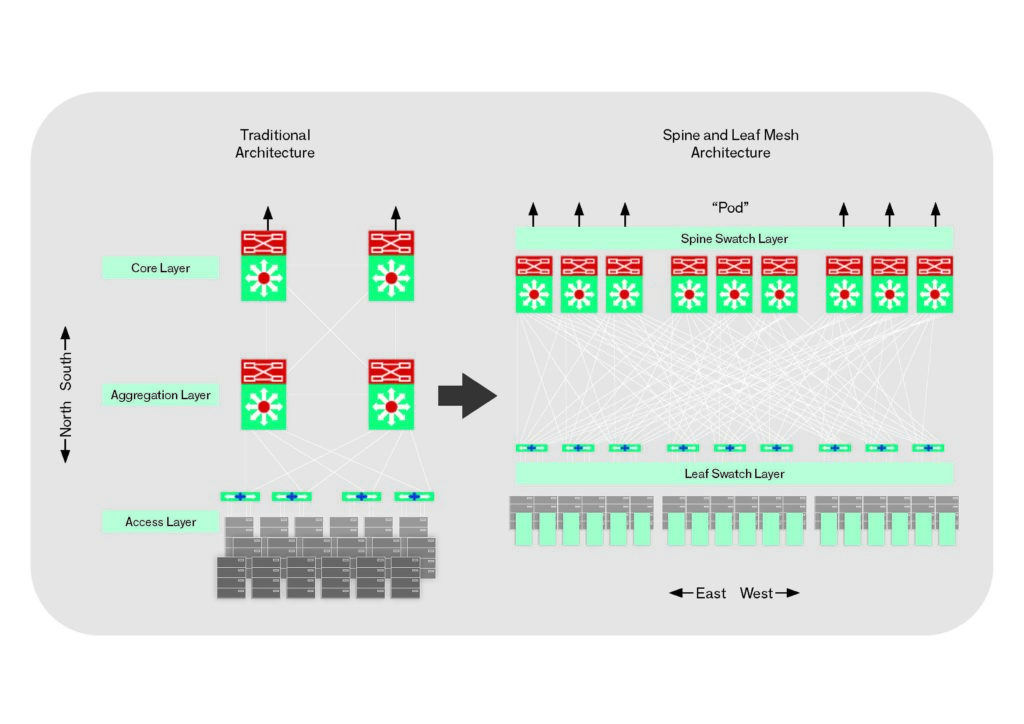Brett Neilson and Tanya Notley
When people hear the term data center architectures they are likely to conjure images of large non-descript box buildings or perhaps of converted manufacturing warehouses. Far less likely will they consider the more opaque and hidden interior network architectures that connect machines inside data centers, even though these topologies are, operationally, much more influential.
The great allure of data centres is that their network architectures allow actors that operate within them to extend their activities territorially by establishing links with distant client machines. In doing so, data centres change the relationship these actors have with labour forces. To understand the client footprint produced by data centres as a form of territory is to treat these facilities not only as digital infrastructures but also as political institutions that influence the wielding of power across wide geographical vistas.
By paying analytical attention to the forms of power produced and sustained by data centre operations, we seek to extend the debate concerning the rising importance of these facilities in order to consider their implications for labour forces, workers and political struggle.
Server-client territories
The server–client relationship underlies the network architectures that data centres establish and implement with machines that operate outside their big box structures. In a server–client architecture, all computers connected to a network are either servers or clients. The former run programs or applications that share their resources with clients. The latter do not share resources but request content or service functions from servers. Clients distribute themselves around data centres, although not necessarily in spatial proximity.
However, this relation between servers and clients, also known as a north-south network relation, is not the only one that data centres enact. Because data centres concentrate servers under one roof, and allow the establishment of peering connections – where servers can exchange data ‘east to west’ quickly with cables plugged in to connect one server with another – they become powerful sites of data storage and service delivery.
To enter a data centre is to encounter a space devoted to the efficient operation of technical systems and largely devoid of human bodies and labour. Yet the humming fans and flashing lights on servers register the presence of distant labour forces that connect to the facility, knowingly or otherwise, at the client end. These may be traditional labour forces, however hired or located. Alternatively, they might be users, such as those who offer up data on social media platforms in return for the use of ‘free’ services.
Data centres store, process and transmit data from clients spread across diverse spaces and scales. This enables those actors who hire or place servers in these facilities to engage in economies of extraction that process, aggregate, analyse, use and sell data generated by these same clients.
For example, organisations with servers in data centres quartered in Singapore are predominantly interested in this location as an efficient and secure gateway to data sources and digital services operating within the South East Asian region. Singapore has advanced data infrastructure, attractive tax rates, flexible labour laws (for skilled migrants), and start-up and lucrative R and D incentives that have allowed the data industries to flourish. Singapore is also geographically sheltered from natural data disrupters: it is not prone to earthquakes, cyclones and tsunamis like many of its neighboring nations. There are 70 to 75 very large data centres in the country, which constitute about half of South East Asia’s total data centre capacity.

The presence of a company like Telin (Telkom Indonesia), which runs three data centres in Singapore under a local subsidiary, means that much of the data generated by this firm’s clients is stored and routed through facilities in Singapore. Not only do Telin’s Singapore data centres offer a launch pad for companies seeking to market digital products and services to the expanding ranks of Internet users in Indonesia but they also provide service capacities for Indonesian companies and institutions that connect to Telin’s national ICT networks.
Data centres generate a client footprint, or territory, which follows patterns of networked distribution and cuts across the exclusivity and contiguity of state territories. Yet because data centres obscure relations between clients and can only pass information through the mediation of servers, such patterns of territorial networking remain invisible to almost everyone, at least to those actors that are not organisations operating within such facilities. Data centres market their territorial reach to enterprises interested in hiring server space, giving territory a fungible quality. By this, we mean that the conceptualisation of territory by data centre operators and users is characterised as much by openness and receptivity to patterns of economic exchange as it is to the political sovereignty of any particular state.
Telin Singapore, for instance, seeks to attract international business by highlighting its extensive network across the Indonesian archipelago. Yet, given the centrality of digital networking to contemporary forms of governance and rule, the commercial imperative of providing territorial reach to organisations operating in data centres also has wider legal and political implications.
Saskia Sassen notes that networked digital structures integrate ‘only parts of national spaces’ and ‘cross multiple interstate borders with great ease’. Remarking that such networked structures cannot ‘survive without some very material infrastructures, and, often massive conglomerations of buildings’, she describes them as ‘situated territorial spaces’ or ‘new cross-border geographies of centrality’. Although Sassen does not deal directly with data centres, her understanding of these ‘extractive and infrastructural spaces’ registers the way in which data centres produce ‘bordering dynamics’ that are ‘partly formalised, partly emergent, and partly not necessarily meant to be formalised nor to be particularly visible’.
Traffic: north-south and east-west
The capacity of data centres to generate operational spaces that function within but also partly beyond existing law and jurisdictional relations is an important territorial feature of their client footprints. These complex territorial dynamics do not mean that data centres are generic spaces whose geographical location is inconsequential. Although they may have weak social, as opposed to infrastructural, ties to the urban or national contexts in which they exist, these facilities tend to cluster in formally constituted territories that offer a safe harbour for data storage and favourable business environments because of their connectivity to electricity, undersea and overland cables.
Not all data centres (or indeed digital networks) are alike. The first and most obvious difference is between data centres run by single firms for their own operations and those that are multi-user (‘co-location’) data centres that bring servers utilised by different firms under a single roof. Data centres also have different network configurations that effectively form complex and distinct architectures. With names such as closed-tree, Clos, fat-tree, Dcell, BCube, c-Through, Helois, PortLand and Hedera, these network topologies determine how physical machines connect materially to each other (directly or via switches) in data centres. Different topologies imply different trade-offs between network qualities such as speed, redundancy, path diversity, energy conservation and scalability.

A data centre that attracts business from high-frequency financial traders, for instance, is likely to have a Clos topology, since this architecture reduces buffering and favours low latency transmission that provides information from stock markets with minimal delay. By contrast, a large commercial multi-user centre might prefer a fat-tree topology that modularises the servers used by different firms and connects them to each other via electronic switches that lead to a ‘meet-me’ (peering) room. When such a centre supplies software, platforms or infrastructure as a service, however, a more flexible architecture that utilises optical switches to reconfigure during runtime is an attractive option.
The design of network topologies extends outside data centres into cabling systems, while the various architectures available have their own infrastructural histories; for instance, the widely used Clos topology has its origins in 1950s telephone exchanges. Different topologies can combine in a single data centre, for instance, creating hybrid networked architectures that seek to balance and optimise operations.
On top of the physical infrastructure of network topology, a software layer controls the virtualisation process by distributing load and virtual machines across physical machines. With names like Sunbird, Nlyte and Tuangru, data centre infrastructure management software packages bridge information across organisational domains to configure workflows, power use and the like. Technically, this means the interaction with any single client stretches across different physical machines or even across physical machines in different data centres. It also means that data centre operations – including different types of interactions with workforces – become ‘virtualised’ or, put another way, opaque, dispersed, fragmented and hard to pin point as situated in any particular place or time.
Because of developments associated with virtualisation, east–west traffic (between servers in the same facility) increasingly outweighs north–south traffic (between servers and clients located outside of data centres). Typically, a client interacts with a server in the access layer of a data centre, which then refers the query to other servers in the facility to assemble a response and send it back to the client. A search query, for instance, generates only a small amount of traffic between a client and the data centre. However, the response to this simple query generates a massive amount of traffic within the data centre.

Much of this east-west traffic relates to internal queries on user demographics, browsing history, interests, recent purchases, and so forth, and thus supports the extractive business models behind many social media and mobile apps. Yet, because this arrangement means that signals generated by different clients often traffic across the same physical machines, it also generates infrastructural connections among users, firms and labour forces that might otherwise not be obvious.
Current accounts of global production tend to rely on metaphors of chains, flows or networks to trace and explain changing relations among economic actors. However, if we are to account for how the infrastructural conditions specific to digital economies shape relations between users, firms and workforces, we need to supplement political economic analyses that rest on these metaphors with an understanding of the new data architectures that determine the nature of operations inside data centres.
We are aware that the physical production of material commodities continues to expand at the global scale and that we cannot understand digital labour in separation from a wider analysis of changing divisions of labour. However, information networks have been crucial to the social expansion of labour beyond the walls of the factory and the office. Informatisation also reorients other modes of production, from peasant economies altered by the introduction of genetically modified crops to manufacturing industries challenged by new fronts of automation based in artificial intelligence and machine learning.
Artificial intelligence and machine learning also contribute to service economies that are beginning to eclipse the advertising-based business models of large tech firms. Significantly, these technologies require the storage and processing of large amounts of data in data centres, confirming the centrality of these facilities to contemporary operations of capital. If we understand data supply as labour, however, what this situation confirms is that the real engine of these developments is living knowledge, intelligence and subjectivity.
Unpicking networked production topologies
To speak of production topologies is to augment the discussion of the global economy based in metaphors of chains, networks and flows with knowledge of the network architectures that structure operations within and between data centres. Celia Lury, Luciana Parisi and Tiziana Terranova suggest that topology provides a way of describing how ‘a distributed, dynamic configuration of practices is organising the forms of social life’. In their conception, topology is ‘emergent in the practices of ordering, modelling, networking, and mapping that co-constitute culture, technology and science’.
We seek to extend this perspective by bringing a discussion of how data centre networks open to a high degree of variability contribute to relations between firms, users and workforces in the contemporary digital economy. Knowledge of data centre topologies and processes of virtualisation places the relations involved in producing goods and services and reproducing knowledge, capital and labour power in a more dynamic context.
Doubtless, production still sometimes occurs through linear chains and fixed networks; but without an appreciation of the more complex and distributed production relations introduced by data centre topologies, it will be difficult to identify critical points in production processes where workers might effectively apply their agency. This is because data centres provide an infrastructural fix for capitalist actors to skirt traditional labour actions, by designing logistical routes around which to redirect production processes, for instance, or by furnishing technologies of fault tolerance and mirroring that absorb such disturbances in ways that minimise their effects.
Assisting workers to see and understand how data centre production topologies connect them across different countries (or prevent them from being connected) and how they affect their employment statuses and social identities is a first step to imagining new forms of organisation and solidarity adequate to challenge the extractive operations of contemporary digital capitalism.
